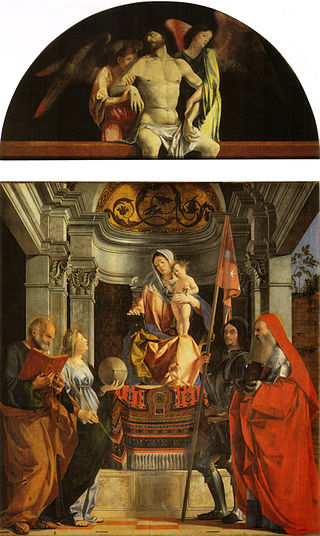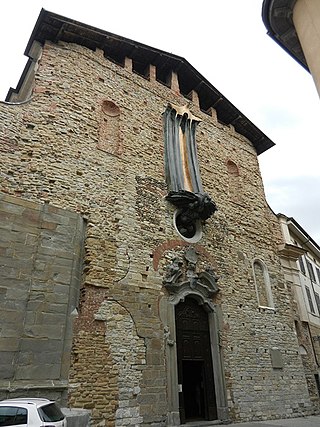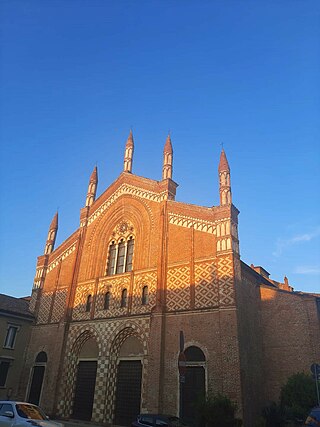
Lorenzo Lotto was an Italian Renaissance painter, draughtsman, and illustrator, traditionally placed in the Venetian school, though much of his career was spent in other north Italian cities. He painted mainly altarpieces, religious subjects and portraits. He was active during the High Renaissance and the first half of the Mannerist period, but his work maintained a generally similar High Renaissance style throughout his career, although his nervous and eccentric posings and distortions represented a transitional stage to the Florentine and Roman Mannerists.

BartolomeoMontagna was an Italian Renaissance painter who mainly worked in Vicenza. He also produced works in Venice, Verona, and Padua. He is most famous for his many Madonnas and his works are known for their soft figures and depiction of eccentric marble architecture. He is considered to be heavily influenced by Giovanni Bellini, in whose workshop he might have worked around 1470. Benedetto Montagna, a productive engraver, was his son and pupil and active until about 1540. He was mentioned in Vasari's Lives as a student of Andrea Mantegna but this is widely contested by art historians.

Alessandro Bonvicino, more commonly known as Moretto, or in Italian Il Moretto da Brescia, was an Italian Renaissance painter from Brescia, where he also mostly worked. His dated works span the period from 1524 to 1554, but he was already described as a master in 1516. He was mainly a painter of altarpieces that tend towards sedateness, mostly for churches in and around Brescia, but also in Bergamo, Milan, Verona, and Asola; many remain in the churches they were painted for. The majority of these are on canvas, but a considerable number, including some large pieces, are created on wood panels. There are only a few surviving drawings from the artist.

Giovanni Battista Cima, also called Cima da Conegliano, was an Italian Renaissance painter, who mostly worked in Venice. He can be considered part of the Venetian school, though he was also influenced by Antonello da Messina, in the emphasis he gives to landscape backgrounds and the tranquil atmosphere of his works.

The Galleria Nazionale d'Arte Antica or National Gallery of Ancient Art is an art museum in Rome, Italy. It is the principal national collection of older paintings in Rome – mostly from before 1800; it does not hold any antiquities. It has two sites: the Palazzo Barberini and the Palazzo Corsini.
Bernardo Castello (1557–1629) was an Italian painter of the late-Mannerist style, active mainly in Genoa and Liguria. He is mainly known as a portrait and historical painter.

The Basilica of San Domenico is one of the major churches in Bologna, Italy. The remains of Saint Dominic, founder of the Order of Preachers (Dominicans), are buried inside the exquisite shrine Arca di San Domenico, made by Nicola Pisano and his workshop, Arnolfo di Cambio and with later additions by Niccolò dell'Arca and the young Michelangelo.

Giovanni Cariani, also known as Giovanni Busi or Il Cariani, was an Italian painter of the high-Renaissance, active in Venice and the Venetian mainland, including Bergamo, thought to be his native city.

Bergamo Cathedral is a Roman Catholic cathedral in Bergamo, Italy, dedicated to Saint Alexander of Bergamo, patron saint of the city. It is the seat of the Bishop of Bergamo.

Giovanni Giacomo Barbelli was an Italian painter of the Baroque period, active in Lombardy. He was a canvas and fresco painter known for his religious and mythological scenes that decorated many churches and residences in Lombardy. He was a highly skilled draughtsman and a brilliant colorist. His work shows an inventive imagination and a thorough knowledge of perspective.

Santa Cristina al Tiverone Altarpiece is an oil-on-panel painting by the Italian Renaissance painter Lorenzo Lotto, executed around 1504–1506. It is still housed in its original location, the parish church of Santa Cristina in Quinto di Treviso, a frazione of Treviso, northern Italy.

San Bernardino in Pignolo is a Roman Catholic church located on Via Pignolo #59, in Bergamo, region of Lombardy, Italy.

Santo Spirito is a Roman Catholic church located on Piazzetta Santo Spirito in Bergamo, in the region of Lombardy, Italy.

San Filippo Neri is a baroque-style, Roman Catholic church located on the intersection of Corso della Republica and via Santa Maria della Porta, in central Macerata, region of Marche, Italy.

Adoration of the Christ Child is an oil-on-panel painting executed in 1523 by Lorenzo Lotto and signed at the bottom right "L. Lotus / 1523". It is now in the National Gallery of Art in Washington.

Madonna and Child with Saint Jerome and Saint Nicholas of Tolentino is an oil-on-canvas painting by Lorenzo Lotto executed c. 1523–1524. It is known to have been in the Dawkins collection in Oxford between 1911 and 1955, before passing to the Heinemann collection in New York. In 1960 it passed to its present owner, the Museum of Fine Arts, Boston, which also owns a workshop version of his Mystic Marriage of St Catherine.

Count Guglielmo Lochis was an Italian nobleman, politician, art collector and art connoisseur.
Madonna and Child with Saints is a common theme in Christian art, and is thus the title of a number of works.

The church of San Francesco of Assisi is a Catholic religious building in Pavia, Lombardy, Italy.
The San Giacomo Altarpiece is a 1515 oil on panel painting by Palma Vecchio which hangs in the church of San Giacomo Maggiore in the Peghera district of Taleggio, Lombardy. It is also known as Pietà with Saint James, Saint Sebastian and Saint Roch.

















